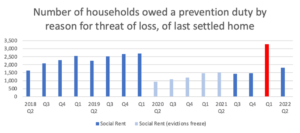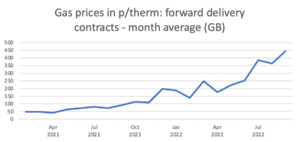Recent data published by the UK government reveals signs of a potential homelessness crisis in England. Sensitivity to energy price volatility may make social housing rent unaffordable.
If there is a threat of home loss, tenants are eligible for a prevention duty. These are support measures provided by local councils. According to official data on statutory homelessness in England, 1,470 social housing tenants were owed this benefit on the basis of the threat of home loss in the fourth quarter of 2021. This number more than doubled to 3,270 social housing tenants in the first quarter of 2022 before settling back to 1,810 in the next three months.

These figures may seem incremental when taking the size of the overall housing market into account. However, such a spike in data cannot just be attributed to statistical noise. Indeed, historically, homelessness has not exhibited such fluctuations. Energy price volatility appears to be the most plausible explanation for this spike in the threat of home loss for social housing tenants. If correct, this assumption implies that a growing number of households in social housing might find themselves on the edge of homelessness as the energy crisis escalates.
Social housing is usually seen as the last resort for financially vulnerable groups. By design, it is cheaper than private and affordable rent. While tenants are more protected in social housing, people still face the threat of eviction if the rent is not paid. If people are evicted from social housing, their only remaining options are often temporary accommodation or rough sleeping.
It is remarkable that the mentioned ‘bell shape’ spike in the threat of home loss is observed in the private sector as well. The number of people claiming benefits rises in the first quarter and falls in the second quarter of 2022. However, these changes are proportionally less significant than in the social sector. This is likely to be caused by private renters’ greater financial resilience and the availability of social housing as an alternative.
Statutory homelessness figures reveal that problems with rent payments are the primary reason for the threat of home loss. Therefore, the spike in the threat of home loss seen in the first quarter of 2022 had to be driven by factors affecting households’ finances. Such factors may include policy change, employment shifts and inflation.
There were no major, relevant government policy changes at the end of 2021 and the beginning of 2022. Unemployment was steadily declining throughout the period. There was a rise in the number of claimants of the housing component of Universal Credit in the social housing sector. However, there were no major fluctuations during that period.
The most volatile macroeconomic indicator for that period is inflation and changes in energy prices in particular. According to Ofgem, wholesale gas prices increased to a record high in the fourth quarter of 2021. The rise had been mitigated in the first quarter of 2022 before the effects of the Russian invasion of Ukraine drove the prices up again.

Because of the rise in energy prices, social landlords had to secure energy contracts under unfavourable terms. Greater energy expenditure meant higher rents and energy bills for social housing tenants. Available data indicates that market average tariffs for households rose substantially in the fourth quarter of 2021 shortly after Ofgem lifted the energy price cap.
This is consistent with the Office for National Statistics’ February publication which demonstrates that energy price increases disproportionately affect those on lower incomes. The lag in the effect arises due to time gaps between market energy price fluctuations, households’ savings drain and prevention duty claim registration. Such sensitivity would explain the decrease in prevention duty cases from April to June this year. Energy bills stabilised in the first quarter of 2022. Hence, there was less pressure on consumers’ budgets and fewer people were pushed to seek help from local councils in the second quarter of 2022.
Overall, this provides two insights. First, households in social housing are likely to be highly sensitive to changes in energy prices. If private renters have options when rent cannot be paid, homelessness is almost the only alternative when social housing rent is unaffordable. Second, the energy crisis does not only affect individuals’ finances but also affects households with a lag. It takes time for the energy price volatility to pass on to renters’ budgets.
As energy prices are rising way above the levels seen in the fourth quarter of 2021, local councils may now face a growing number of people on the edge of homelessness in social housing. Since the beginning of the year, Ofgem has increased the energy tariff cap twice. According to Ofgem figures, average standard variable tariffs provided by Large Legacy suppliers rose by 54% in April and most recently went up by 27% in October 2022.
The energy price guarantee adjustments announced by the government in the Autumn Statement as well as the 7% rent increase cap for the social sector are steps towards preventing the homelessness crisis. The analysis here nonetheless suggests that social housing may require even greater attention. Since the effect of energy price increases is delayed, acting early will be the best strategy.
Mikhail Korneev is a Research Assistant at Bright Blue. Views expressed in this article are those of the author, not necessarily those of Bright Blue. [Image: Nick Fewings]





